Agricultural and Biological Systems Engineering, Department of

Department of Agricultural and Biological Systems Engineering: Presentations and White Papers
Date of this Version
May 2005
Document Type
Article
Abstract
The Odor Footprint Tool is a science-based computer resource for use in evaluating the potential odor impact of new and expanded animal production facilities. It was developed to assist livestock producers, their service providers, and county planning and zoning officials in making reasonable decisions while limiting the negative impact of livestock operations on surrounding neighbors and rural communities. The Odor Footprint Tool utilizes an EPA regulatory model (AERMOD), weather databases, new source code, and user input to generate regional odor roses, odor footprints, and directional setback distance curves. Odor roses provide a generic picture of the directionality of odor impact within a region, independent of the type or size of livestock facility involved. Odor roses are well suited for general educational purposes where the directional impacts of odor emissions from an unspecified source are desired. Odor footprints show a plan view of the projected odor impact of an operation, based upon the total odor emission rate of the site. The total emission rate depends on the type of livestock housing and/or manure storage facilities involved, and whether any odor control technologies are implemented. Odor footprints can be developed for specific scenarios, and are most useful for visualizing the projected odor impact of an operation on the surrounding area. Directional setback distance curves facilitate determining minimum recommended setback distances in four 90-degree sectors around a site. The directional setback distance curves are useful when key setback distances are desired, and when a number of preliminary comparisons are to be made. Further development of the Odor Footprint Tool will facilitate generation of site-specific odor footprints.


Comments
Paper presented at Livestock Environment VII, Proceedings of the Seventh International Symposium, 18-20 May 2005 (Beijing, China). Publication Date 18 May 2005, ASAE Publication Number 701P0205. Ed. T. Brown-Brandl. Copyright 2005 American Society of Agricultural Engineers, St. Joseph, Michigan USA. Copyright © 2005 R. Stowell, L. Koppolu, D. Schulte, and R. Koelsch.